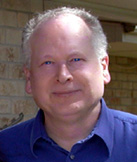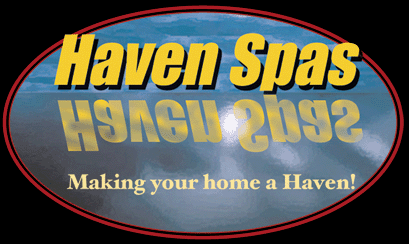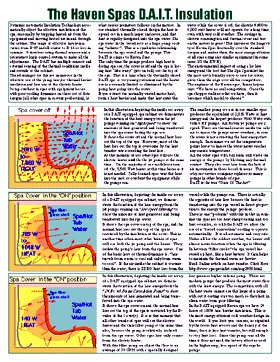|
|
Quality Spas and Hot TubsHavenmade Inc.SPA TIPS
Article on Bromine and Ozone. "Promoting ethics in the spa industry." |
Thank you for visiting our site! Email us with hot tub questions  |
Weekly newsletter for spa owners and prospective spa owners.
published on the web by |
Long before non-chlorine shock, people would shock with
chlorine
in their spas. It still is a good way to shock. Get the chlorine levels
to about 8 to 10 PPM and if "fries" all the bugs and organic matter in
the water. After about an 24 hours the levels drop to below 3 PPM. You
want to shock at a pH of 7.2 for most effectiveness. However, I prefer
and recommend the non-chlorine shock with potassium peroxymonosulfate
combined
with dichlor at a ratio of 1 tablespoon MPS shock to 1 teaspoon of
Dichlor.
This way you will have a sharp rise in the oxidizer which burns
out
the garbage from the water. Then it rapidly falls to below 3 PPM
in
less than one or two hours. It is good to burn out all the orgainic contaminents
once
a week and remove any residual "dead and smelly" bromamines. It
reactivates
the bromine. Bromine lowers pH and ozone raise your pH very slightly. Chlorine (dichlor) lowers pH very slightly. The products called "granulated Bromine" are about 50/50 chlorine and bromine, and are almost neutral in pH. MPS shock has the effect of lowering pH, but it is one of the best ways to burn out organic contaminents without raising the resudual sanitizer levels too high. When you use MPS (non-chlorine shock), you use the Total Alkalininty to help hold up the pH against the acids of both the bromine and the shock. That is why a bromine or chlorine spa needs to have a higher total alkalininty than an ionized spa, with much less acids being introduced into the water. Bromine tabs in a floating feeder, is the most economical way to use bromine. The feeder must be placed away from the filter, and not in direct flow of the jets, otherwise the bromine dissolves too fast. By keeping the feeder away from the filter, the bromine doesn't build up in front of the filter and harm the equipment. If your spas has a bromine feeded in the filter door, this is the worst design there is. The bromine goes up and then dies as the tablets dissolve way too fast. The levels can get as high as 30 to 40 PPM directly in front of the filter, and then go straight into the equipment, helping it to corrode. I have always disliked the weir door feeder or feeders inside the filter housing for that reason. My Sun;;;ce customers complain that the tablets dissolve too fast, and they can't maintain a steady level of bromine. It just goes up and down. Coleman finally stopped making spas with a filter bromine feeder for the same reason. In the store where I worked we were told by Coleman to open the filter and throw the filter feeders in the trash. You want to keep a residual amount of bromine in the water at all times, with chlorine, this is nearly impossible. It bounces all over the place in hot , highly agitated and areated water. You can keep a good residual of bromine with a floating feeder kept away from too much water flow. It can be supplimented with granular bromine (about 50/50 bromine/chlorine. The chlorine, in the mix, activates the soduim bromide.) Pure bromine tablets require regular applications of either granular chlorine (dichlor) or non-chlorine, potassiumperoximonsulfate, shock to activate the bromine (convert sodium bromide into bromine) If you have the Taylor test kit, the booklet tells how to calculate the number of days between drain and refill. What happens in spa water is similar to taking sugar and adding it to a jar of water. If you keep adding sugar, eventually the sugar stops dissolving and remains solid in the bottom of the jar. It recommends that you divide the volume of water by 3 to get the number of daily bathers. To me this is a little short on time with ions or other methods that do not introduce high levels of solids to the water. With ionized (and the Eco One) spas you can go much longer between drain and fill. In a spa, the water starts to have a "slow response" to the powders we add. For instance, you might look up in the table and it says to ad two tablespoons of pH down. After you add the pH down, the pH doesn't change as much as it "should". If the water doesn't respond it needs to be changed. In an average spa the time between changes is from three to six months. ( This is also the reason for using the "acid demand" test to determine how much pH down to put in. As the water naturally ages it takes on more pH change resistance and the ONLY way to tell exactly how much product to put in is the "demand" tests, "base demand" or "acid demand".) There are other methods besides bromine which we will cover in other issues of Spa Care Tips.
Havenmade Inc.The experts on hot tubs and spas.3Broomfield, Co 8002 (303) 404-2224 |
 Find our how to install a hot tub indoors correctly! |



